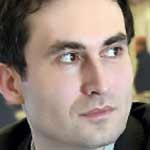
Dr Stefan Hördler
Director of the Mittelbau-Dora Concentration Camp Memorial
The Holocaust Exhibition and Learning Centre hosted Dr Stefan Hördler's public lecture on the 'Auschwitz Album' looking in detail at the perpetrator photography it contains. The following Sunday the Centre also hosted a Holocaust Survivor talk with Leisel Carter. View Dr Hördler's public lecture n the video below.
A COLLECTION of photographs known as the ‘Auschwitz Album’ is the only surviving photographic evidence of Hungarian Jews arriving at Auschwitz and the horrific selection process they were forced to go through as they stepped down off the cattle wagons. But, why were they taken and who commissioned such an album in the first place?
These questions and more were the focus of a talk by Dr Stefan Hördler, Director of the Mittelbau-Dora Concentration Camp Memorial, when he delivered a public lecture at the Holocaust Exhibition and Learning Centre in West Yorkshire. The Centre was developed in association with the Leeds-based Holocaust Survivors’ Friendship Association and is based at the University of Huddersfield.
During his talk which you can view below, he looked into new research into the ‘Auschwitz Album’ and demonstrated that it is, above all, an internal propaganda project that celebrates SS efficiency during the deportation of the Jews from Hungary.
He raised questions about how the album was commissioned, made and shared, and about the staging of a number of the images, reminding us that historians should examine photographic evidence just as critically as textual sources.
The ‘Auschwitz Album’ documents the arrival of thousands of Hungarian Jews at Auschwitz after a three-day journey on cattle wagons and the process of selection and dehumanisation that followed. The fact the album had been discovered at all was a miracle and it was discovered by a young lady called Lili Jacob.
On the day of her liberation, in the Dora concentration camp - hundreds of miles from Auschwitz – Lili found a photo album in a bedside cabinet in the deserted SS barracks. It contained, among others, pictures of her family and friends as they arrived on the ramp and unknowingly awaited their death. It was a unique and invaluable tie to what once had been, could never return, and could never be rebuilt.
The photographs in the ‘Auschwitz Album’ have been central to how the camp is represented and to the way in which the ‘Final Solution’ has been interpreted. It has shaped representations of the Holocaust in film, literature and documentaries.
The ‘Auschwitz Album’ - a guest lecture by Dr Stefan Hördler
A collection of photographs known as the ‘Auschwitz Album’ is the only surviving photographic evidence of Hungarian Jews on their arrival to the Auschwitz concentration camp and the horrific selection process they were forced to go through as they stepped down off the cattle wagons. But, why were they taken and who commissioned such an album in the first place?
In this lecture, historian Dr Stefan Hördler reveals the album wasn't created to document the horrors of the Holocaust as many experts initially thought but, that it was actually created to show how efficient the Nazi's were at selecting and killing thousands of Hungarian Jews on their arrival at Auschwitz in 1944. He believes the album contains 'perpetrator photography' and explains the sordid details behind why certain photos were taken.
You can watch more of the University's video content on our YouTube News Channel.
Holocaust Survivor talk
Later the following week, on Sunday 09 June, Leisel Carter - a Holocaust survivor - came to talk at the Holocaust Exhibition and Learning Centre and spoke about her life and how she escaped the Holocaust.
Leisel - whose brother later married Lili Jacob - escaped the mass genocide that sadly killed most of her family at the tender age of just four-years-old. She left Germany in 1939, just before the start of the war and amazingly, for most of the journey to England, she travelled on her own.
She arrived in England during January 1940 after travelling through Germany, Sweden and Norway, where she stayed for a short time with the Alfsens, a Norwegian-family, before making the final voyage to the safety of England’s shores.
While Leisel’s story ultimately has a happy ending after being placed in Leeds with foster parents Jack and Mary Wynne, she like so many, lost most of her family to the Holocaust. She never knew her father: he was beaten up in the street when Leisel was just 18 months old and later died in a concentration camp. She knows very little about her grandparents and other family members.
During her talk, Leisel explained how in the 1980s she managed to finally trace her journey to England when she was reunited with the Norwegian foster family who helped to save her life. She reflected on her family’s experiences and their resonance for contemporary Britain.
More news
Escaping death at Auschwitz – Arek Hersh
Arek Hersh was born in Poland in 1928, but from the age of eleven the Jewish boy was sent by the Nazis to his first concentration camp
Subscribe to the University's YouTube news channel
The University produces lots of content featuring research, VIP interviews and visits, guest lectures and more.
Holocaust Exhibition and Learning Centre opens
The Centre is one of only two centres in the UK and will primarily serve the North of England
